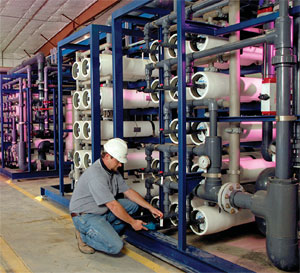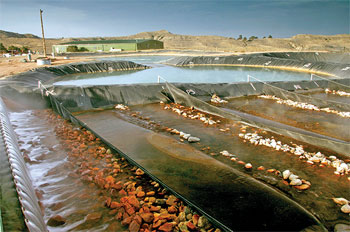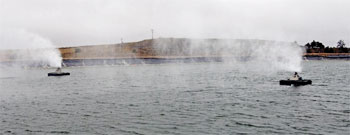Produced Water Report
Operator uses innovative water treatment technology to meet discharge regulations
Coalbed methane dewatering programs can create an enormous amount of water. A cost-effective, flexible approach gets the job done.
Hari Gupta, Siemens Water Technologies
Petro-Canada needed to treat the produced water from a Coal Bed Methane (CBM) project to meet discharge regulations and minimize waste volumes. In 2004, the company acquired assets in the US Rocky Mountain region to strengthen its gas business. The Powder River basin area near Gillette, Wyoming, is home to many gas wells, including Petro-Canada’s Wild Turkey CBM project.
CBM wells usually have to be dewatered to reduce pressure and allow methane gas to be released from the coal. This produced water often contains contaminants that have to be removed before the water can be discharged into public water streams. Petro-Canada worked with Siemens Water Technologies to determine the most cost-effective and efficient way to treat and dispose the large quantities of produced water.
BACKGROUND
The Water Quality Division of the Wyoming Department of Environmental Quality (WDEQ) is responsible for the Environmental Protection Agency’s NPDES (National Pollutants Discharge Elimination System) program for Wyoming. Petro-Canada filed for and received a water discharge permit for its Wild Turkey project from the WDEQ.
Water analysis showed a high level of sodium, which had to be reduced per WDEQ requirements. Petro-Canada looked at various technologies, such as Ion Exchange (IX), Reverse Osmosis (RO) and others to reduce the amount of solids in this produced water, and chose the RO solution from Siemens Water Technologies.
Another challenge was to minimize the waste stream volume, because deep well injection or hauling the waste off site was very expensive. Brine Recovery RO (BRRO) was chosen for this aspect of the project. An RO-based treatment system would not only remove more sodium from the water, but would also achieve an overall higher water recovery rate. And, as it turned out, RO-based technology was also the most cost-effective method to treat this water.
There were four factors in selecting Siemens, according to Chuck Pollard, VP of Engineering and Operations for Petro-Canada’s US Operations: “Cost-effectiveness of the process, the vendor’s flexibility in being able to treat the water even if the influent quality changed, the ability to move the equipment and use it elsewhere, and the reliability of the equipment. But probably the most important reason was that the vendor was willing to put guarantees in writing. Other vendors who were considered would not do that.”
“During the negotiation process, the contractor assured us that the technology would allow us to meet our permit requirements, and, in fact, they told us that this technology had treated water a lot worse than ours,” says Pollard. “So, the only remaining issue was how much wastewater we would have, and, again, they assured us that the brine recovery RO would recover enough water so that the waste stream would be minimized.” Petro-Canada finalized project negotiations and agreements in June 2005.
Petro-Canada needed to begin treating the water immediately, so mobile water treatment equipment was brought to the site. “We had wells drilled that we weren’t able to produce because of the high sodium levels, and we needed a quick solution,” says Pollard. The mobile treatment system included media filtration and RO to treat the water, and was used from November 2005 until the permanent system was commissioned on May 20, 2006.
THE SYSTEM
The permanent water system consists of six parallel treatment trains. The modular design allows the system to start up with one train at a time, with more trains being placed in operation as new wells are brought online. Three to four trains are now operating to treat the incoming water. The plant is designed to treat 5 million gal/day (120,000 bpd).
The permanent water treatment system consists of iron removal, media filtration, chemical feed(s), a primary RO system (Fig. 1), a brine recovery RO system and a raw water/treated water blending system. Water from the CBM wells is pumped to the treatment facility via a ballast pond, Fig. 2. A portion of the incoming raw water (45–50%) is treated using the media filters to remove iron and other suspended impurities that could plug the RO membranes. The primary RO removes about 95% of dissolved salts, and produces 80 to 85% of treated water and 15 to 20% of reject stream.
 |
Fig. 1. The RO-based treatment system prepares the water for surface discharge at a high water recovery rate.
|
|
 |
Fig. 2. The produced water stream is piped to a ballast pond before being pumped to the treatment facility.
|
|
The brine or reject stream from the primary RO system is further treated in a brine recovery RO (BRRO) system to recover additional treated water. The combined water recovery in both RO systems is between 90 and 95%. The combined, treated RO product water is sufficiently good to allow some blending with incoming raw water and still meet the overall discharge water quality. The blending process increases overall water recovery to between 95 and 98%. The blending ratio is adjusted automatically, depending on the incoming raw water quality. The final reject water is then sent to evaporation ponds, Fig. 3.
 |
Fig. 3. The wastewater from the RO systems is sent to evaporation ponds.
|
|
The dissolved sodium in the influent stream is between 493 mg/l and 640 mg/l. The water treatment system is designed to remove sodium down to 325 mg/l to meet discharge requirements.
The location is very remote, and the contractor has extensive experience operating these types of systems. So, in addition to designing, building, installing and commissioning the water treatment system, the contractor is under a five-year operating and maintenance contract. The contractor has two technicians available at all times, and they do everything from taking influent and effluent water samples and monitoring system operation to cleaning the RO units and changing the cartridges.
CONCLUSION
Representatives from the EPA’s Office of Science and Technology (OST), as well as from the WDEQ, visited the Wild Turkey site. To date, the RO facility has performed according to the permit requirements.
“The water treatment plant and the operating contract are working out very well for us,” says Pollard. “The system effluent is meeting the discharge requirements for sodium and other parameters, and the waste stream volumes are manageable. We are very happy that we took this innovative approach to water handling for our Wild Turkey CBM project."
|
THE AUTHOR
|
|
Hari Gupta is Director of GI/ MOSS Applications Engineering Group at Siemens Water Technologies. With over 33 years in water and waste water service operations, he has extensive experience in membrane applications, trouble shooting, and system design. Mr. Gupta holds a Master�s degree in chemical engineering from the University of California at Berkeley. He can be reached by e-mail at hari.gupta@siemens.com.
|
|
|





